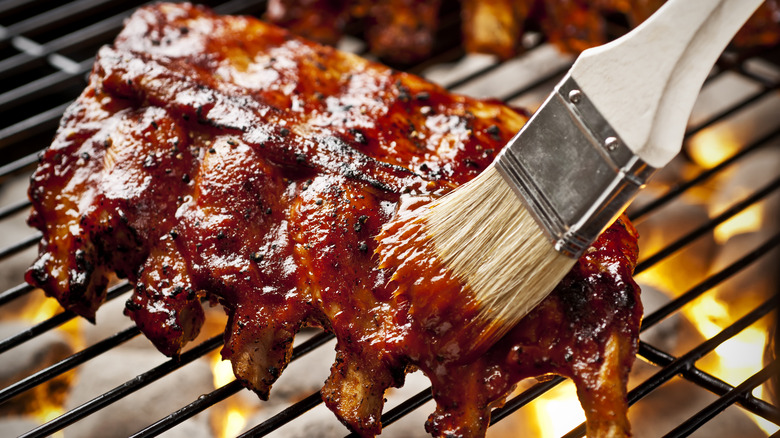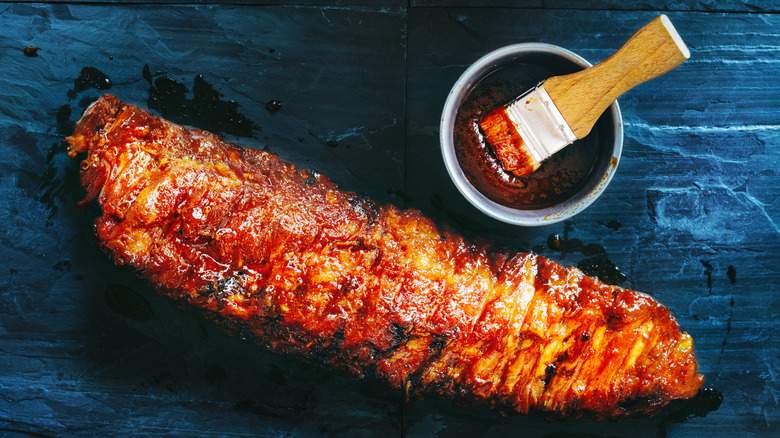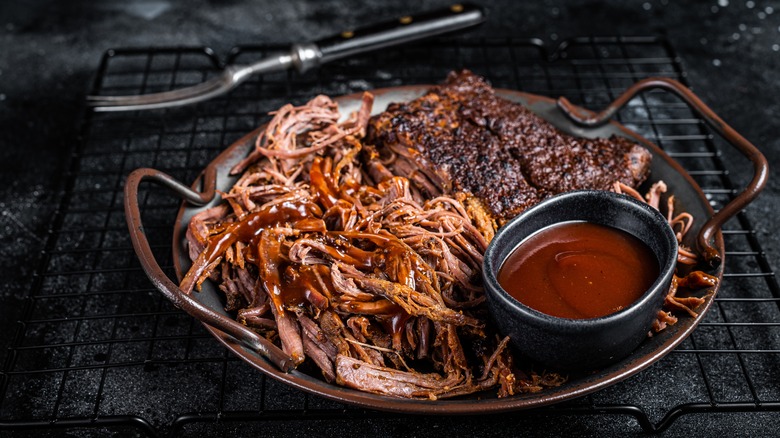The Easiest Way To Avoid Burning Barbecue Sauce On The Grill
In virtually every style of American barbecue, meats are basted and dressed in a little (or a lot!) of sauce. While an Alabama white barbecue sauce or a North Carolina vinegar-based sauce are undoubtedly iconic, many of us associate smoky chicken or a rack of ribs with a finger-licking spicy, sweet, and tangy sauce known as the Kansas City-style. This classic condiment adds a welcome richness to the meat in addition to flavor, but if you add it at the wrong time, the only flavor you might taste is a burnt and bitter one.
If barbecue sauce is brushed on after meat has finished cooking, it's often too late to give the flavors time to sink in. But if you add sauce too early in the process, it can easily burn, leading to an exterior that's charred all in the wrong ways. This is a quick way to ruin what is often a lengthy and careful smoking and grilling process.
To avoid both of these pitfalls, the best time to add sauce is towards the end of the meat's cooking time. The goal is to infuse the meat with all those delicious flavors, and for the outer layer of sauce to caramelize, but not burn. This way, the sauce can enhance both the taste and texture of the meat and as a bonus, it creates a lot less mess on the grill. But why do most barbecue sauces burn so easily, anyhow?
Adding barbecue sauce near the end prevents scorching
Most barbecue sauces burn easily due to their sugar content. A lot of recipes feature ingredients such as molasses, brown sugar, or honey, and less conventional versions like Coca-Cola barbecue sauce are even sweeter. Sugar begins to burn at around 265 degrees Fahrenheit, but your grill should be way hotter than that to crisp up the surface of meats while keeping the inside juicy. If the meat is glazed in sauce too early, the sugar will scorch in no time, imparting an acrid flavor and unappetizing gummy or hard texture.
As for when exactly to apply the sauce, it will depend on the meat you're working with, but a good rule of thumb is brush on sauce about 10 minutes before the meat finishes cooking. If you like, you can continue to brush the meat with two or three extra coatings until it's ready to come off the grill. Be sure to flip the pieces of protein between each application, so that both sides are evenly coated.
An exception to this rule is ribs, which go especially well with barbecue sauce and can handle a more generous coating. The best time to brush a rack with sauce is during the last 20 to 30 minutes of cooking time, or even up to an hour before it's done. Just apply the sauce in thin layers, so it can build up and become beautifully sticky as well as tasting great.
How to make barbecue sauce easier to use
While it's popular to apply barbecue sauce during the grilling process, many barbecue aficionados view sauce as a condiment to be served alongside meats. True, the sauce's flavors don't infuse into the meat this way, but some prefer to let the taste of ribs, chicken, brisket, and more to shine on their own. If you're worried about burning, you could always serve sauce on the side, as plenty of pros do.
If you do prefer to apply sauce during cooking, but you're afraid of burning it, try thinning the condiment with a little water. It will be easier to brush on, which helps you apply it in thinner layers, and it's also less likely to burn or form a pasty layer that isn't sticky nor crisp.
When you're already buying, trimming, possibly smoking, and then grilling meat, making a sauce from scratch can add even more work. There's really no shame in using a store-bought kind — even pro chef Bobby Flay is partial to bottled barbecue sauce, with his favorite brand being Bone Suckin' Sauce. Alternatively, try spritzing barbecued meat with a spray bottle of whiskey as it cooks, for a boost of smoky flavor and tender texture. Or, opt for marinades and rubs, which are added before the meat cooks and pack a punch of flavor without the risk of burning.



